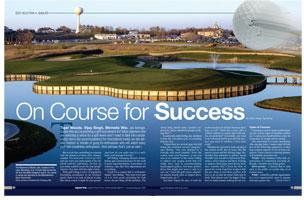
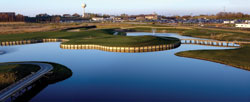 |
| The Meadows at Mystic Lake, located in Prior Lake, Minnesota, is an 18-hole daily fee Garrett Gill and Paul Miller designed course. The course is owned and operated by the Mdewakanton Sioux Community. Photo courtesy of Duininck Golf, Prinsburg, MN |
Tiger Woods. Vijay Singh. Michelle Wie. Joe Average. Guess who you're planning a golf tournament for? Most planners who are selecting a venue for a golf event won't need to take into consideration items like accommodations for international media, on-site athletic trainers or hordes of gung-ho enthusiasts who will watch every shot with breathless anticipation. (And perhaps that's just as well.)
But you do have something in common with the planners of those lofty championships: You need your event to go well, and you want your participants to be satisfied with the experience. So how do you create a perfect event for your group? Answer: You start with the right course.
With golf riding a wave of popularity (including acceptance as an Olympic sport), there is no lack of places to play. But which course is right for your group? And how do you make sure it's a well-built, well-managed facility?
Jeff Bollig, managing director of marketing and communications for the Golf Course Superintendents Association of America, says that first impressions are everything.
"Look for a course that is well-maintained," says Bollig. "You want every part of it to look good, including the club house, the pro shop, all the facilities. The whole thing should make a positive impression, and so should the people working there."
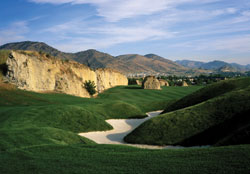 |
| Photo courtesy of American Civil Constructors, Littleton, Colorado |
In particular, adds Bollig, pay attention to how the visit makes you, as a meeting planner, feel.
"I think there are several signs that fall along the customer service category," says Bollig. "Are you greeted in a friendly and warm manner? Does the course want your business, or are you seen as an irritation? Is the course willing to address any unique needs that you might have such as accommodating handicapped golfers, first-time golfers, those that might just want to ride in a cart, etc.? Does the golf course administer special awards such as longest drive, longest putt, etc.?"
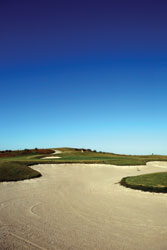 |
| The River Ridge Golf Club, a 36-hole daily fee facility in Oxnard, California, is an exellent example of land reuse. Twenty of the 36 holes are built on top of an old landfill. Photo courtesy of Duininck Golf, Prinsburg, MN |
And don't forget, he says, to look for professionalism in all their business dealings as well. "Does the course offer a written contract to ensure that both parties are protected? Essentially, you want to be welcomed and be provided the services you need to conduct a first class event."
Planners are advised to look not just at the course itself, but at areas like the practice green and the driving range. Remember that attention to golfers' needs shouldn't just extend to experienced foursomes; novice players and those looking to improve their game need decent facilities. Another hint? Check the flow of guests for overly long lines in places like the pro shop or anywhere golfers will have to go to pick up rental clubs and so forth. Your players won't be happy if they have to stand around waiting for service.
Types of Courses
Choosing a course means understanding the various types of facilities golfers use. Courses are classified three ways: by ownership, by length and by setting.
The ownership of a course determines who can play there. Courses may fall into any of the following categories,or they may combine aspects of two or more categories. Those courses a meeting planner will probably encounter are:
Private - only members of the club, organization or community can play, although a member may bring guests
Semi-private - a facility that is only open to the public on certain days or at certain times
Public - owned by a private organization or a civic organization; open to anyone who pays greens fees
Municipal - owned by a city, a town, etc.; open to anyone who pays greens fees
Resort - owned by a resort or hotel; accessibility varies; some resorts restrict facilities to guest use, some may sell memberships, and some are open to the public
Military, University/College and Corporate - These facilities are built for specific users (the military, students/faculty members or company employees). Users generally can bring guests. Like resort courses, facilities may be open to the public or they may accept membership.
Residential/Community - owned or managed by a community or a community association, and generally used only by residents and their guests
As a side note, many of the above courses may also operate on a "daily fee," or "pay-as-you-play" basis.
"Many pay-as-you-play courses, resort courses and/or private clubs are well-suited to a variety of tournaments for both recreational events and various levels of tournament play," says Doug Carrick of the American Society of Golf Course Architects. Courses that host PGA Tour events are generally chosen for their location, their overall length and challenge, along with other facilities to support parking, large galleries, corporate tents, tournament merchandising and sales etc."
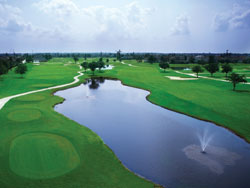 Courses are also categorized by length. Shorter courses might include par three or executive courses, but competitive tournament play usually takes place on a championship course. According to Carrick, championship courses "are generally considered to be between a par of 70 and 72 for 18 holes and are of an overall length and quality that is suitable for staging a tournament that would provide a challenging test for skilled golfers. Championship courses can also be accommodating to everyday golfers of average skill."
Courses are also categorized by length. Shorter courses might include par three or executive courses, but competitive tournament play usually takes place on a championship course. According to Carrick, championship courses "are generally considered to be between a par of 70 and 72 for 18 holes and are of an overall length and quality that is suitable for staging a tournament that would provide a challenging test for skilled golfers. Championship courses can also be accommodating to everyday golfers of average skill."
"The qualities that separate a facility for fun recreational events from more competitive tournaments relate to many of the items noted above," says Carrick. "The greatest emphasis for a competitive tournament course is the length and challenge of the course, the quality of the course layout, the quality of the course conditions (i.e., the level of maintenance) and the ancillary facilities (i.e., parking, clubhouse, location etc.)."
Classification of Courses
Courses may also be classified by setting, including topography as well as scenery:
Links golf courses have rolling hills, no trees and expanses of open land. They are intended to resemble the courses in eastern Scotland where the game of golf originated.
Parkland courses have lush greenery, few trees and turf that is kept very short. (This is a popular type of course, and can be found in many states in the U.S.)
Mountain, prairie, forest, desert and oceanside courses are examples of facilities classified by the views the golfer has while playing. In these courses, golf is played not in the mountains, on the beach, etc., but players can see these things around them. (The general topography and slope of the course, however, may reflect some of the surrounding land; for example, a prairie course is rather flat).
Heathland courses have gentle slopes and low shrubs; they are designed to resemble the inland courses in England and Scotland.
Downs courses have gentle slopes and long, flat stretches of grass; they are designed to resemble the English downs.
A Few More Hints
Find out if another golf event is scheduled for the course on the same day, since it increases the possibility of confusion, crowding, etc. And of course, make sure the location you're choosing has weather that is conducive to golf (or any outdoor sporting activity, really). Inclement weather (particularly thunderstorms) will ruin your event.
Sheasa Lundy and Ricky Maher of American Civil Constructors in Littleton, Colorado say that the skill level of the golfers should always be taken into consideration when selecting a tournament venue, since "the main thing that makes a course more or less difficult is the topography. Typically, courses with more water play, that have more yardage to cover and fewer acres of turf are more difficult. Also, the general geography of the region is a factor. For example, courses in Arizona typically do not have many acres of turf and therefore, you may lose your ball more. The way a course is maintained affects the difficulty as well. The grass can be cut very short, resulting in faster greens, or left a little longer, which makes a shot more difficult."
 Lundy and Maher claim that in general, private courses are more difficult than other types. "They are of a higher quality, more expensive, have more maintenance, and have fewer people playing on them. Public courses are usually built with the ‘average Joe’ in mind. They are more player-friendly and usually don’t have many special features that require high maintenance. The goal for a public course is to get in as many rounds per year as they can, so the grounds are not in great shape usually."
Lundy and Maher claim that in general, private courses are more difficult than other types. "They are of a higher quality, more expensive, have more maintenance, and have fewer people playing on them. Public courses are usually built with the ‘average Joe’ in mind. They are more player-friendly and usually don’t have many special features that require high maintenance. The goal for a public course is to get in as many rounds per year as they can, so the grounds are not in great shape usually."
The event planner, say the experts, should travel through a potential course, keeping an eye out for things that might appeal (or not appeal) to users.
"Cart paths are a neglected item at many facilities," says Art Tucker of Plexipave System, Div. of California Products Corp. in Andover, Massachusetts. "Asphalt and concrete are not zero-maintenance items. They become pitted and raveled either through wear or weathering."
Those who are planning a golf event should learn what amenities a course offers, and what will appeal to the type of client who will be playing.
"For a corporate event needing a relaxing atmosphere, a semi-private or resort-style course may give the best results," says Sheasa Lundy. "Laid back, plenty of drinks for everyone and prizes at the end, or a raffle, are typical. For a golf skill camp, choose a course with larger training areas, such as a large driving range, chipping and putting areas. For a big charity fundraiser or tournament that will attract professional-level players, a high-end private course would probably work best."
A good course, says Jeff Bollig, should want a meeting planner's business and be willing to work with them.
"Golf courses are being extremely creative in attracting business," notes Bollig. "It involves everything from reducing fees to adding value to the package such as free golf balls, free refreshments, free gifts, prizes, etc. Additional price breaks are given for catered meals. Coupons are provided to attendees for a reduced price for a return visit to the golf course. Some golf courses are providing a quick clinic or group lesson to a group who comes to visit. From the golf course superintendent perspective, the focus is on providing an enjoyable set up that provides the appropriate challenge, yet does not frustrate the participants."
Maybe your love of golf comes from years of playing. Maybe your acquaintance with the game simply comes from laughing at the antics of gophers, golfers and groundskeepers in Caddyshack. Either way, you want the event you're planning to be a success for your players and, consequently, for you. The good news is that with the right amount of planning, you can score a hole in one.

